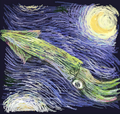Museum d'Alfonsino
Museum d'Alfonsino is a multiplayer stage in Splatoon and Splatoon 3. It takes place in the courtyard of an art museum in Inkopolis. The defining feature of Museum d'Alfonsino is its rotating walls, which are central to navigating the stage.
Layout
Museum d'Alfonsino is a stage that features five rotating displays, which are central to navigation, as well as reaching vantage points. The spawn point of the stage is at a courtyard entrance, with a path to the left leading towards a large rotating display, and a path to the right leading to the center of the stage. Directly in front of the spawn is a small rotating platform with four spokes that spins counterclockwise without stopping. Continuing to move forward leads to large displays with three spokes that rotate a third of the way before stopping for five seconds. When stopped, they align perfectly with the rotating platform in the center of the stage. The large displays are entirely inkable, allowing players to climb up and reach grated platforms on the right side of their walls. The center of the stage is located to the right of these platforms, relative to the spawn point. In the center of the stage is a lower area with a rotating display with four spokes in the middle. It rotates counter-clockwise a quarter of the way before stopping, aligning with the large displays. To the left and right of the center stage are lowered areas with statues where most of the battling on the stage takes place. The sides of the stage contain large pools of water which players must look out for when jumping from the left side route to one of the large rotating displays. In Turf War, the final score is determined by where the rotating platforms stop at the end of the match.
In Splatoon 3 Museum d'Alfonsino returns with some changes. The rotating display in the spawn region was removed entirely and the raised areas on the right have been changed slightly, along with a bit more cover added on the left. The large rotating display closest to the middle has one section removed from it. Glass has been added on the left of it, filling the pit of water. The center has been lowered significantly and more ground is now equal in height with another statue being added.
Ranked Battle terrain
In Ranked Battles, specifications for the terrain or placement of objects are different between the modes; these changes create new paths or new objects to take cover behind.
Splat Zones
The spawn points for both teams have been moved to the first rotating display. The Splat Zone is located in the center of the stage. Inking the rotating display does not count towards capturing the zone. Many platforms and one statue have been added near the center and the central display has been shortened to make jumping on it from both sides easier.
In Splatoon 3 the Splat Zone is located in the center, being slightly bigger than in Splatoon. The display on each team's side has been altered, having 2 sections instead of three and having them directly across from each other.
Tower Control
The spawn points for both teams have been moved to the first rotating display. The Tower in this mode is located at the center of the map, replacing the central display. The goal is found right outside the enemy's spawn point, after going through the giant display. The wall sticking out on both giant displays has been removed and many blocks and barriers have been added, including the platforms from Splat Zones. When the Tower is occupied, it first goes straight and around the outside of the giant display over the water. It then turns left and heads for the goal.
In Splatoon 3, the Tower route remains the same. The ground around the first checkpoint is now entirely level with the center, being all flat and the statue has been moved slightly. The center display only has two spokes instead of four and rotate towards the opponent's base as the Tower gets to the center. The opponent's display has two sections instead of three and the raised area next to it has been expanded making defending easier. A block has been added to the right to allow access to the opponent's base easier.
| In Splatoon 3, checkpoints have been added: | |||||
|---|---|---|---|---|---|
| Checkpoint | Location | Timer (Seconds) | Progress Amount | ||
| Before | After | Total | |||
| 1 | The first checkpoint is located to the right of the central rotating area. | 4 | 85 | 77 | 8 |
| 2 | The second checkpoint is located when the tower first enters the opponent's raised area | 6 | 53 | 41 | 12 |
| 3 | The third checkpoint is located when the tower starts to turn left to the middle of the area. | 3 | 18 | 12 | 6 |
Rainmaker
The Rainmaker starts on top of the shortened central display. The goal is located on the rotating display in the enemy team's spawn point. The giant displays have been altered a bit: they both have one section removed and they now rotate one-third counter-clockwise, then one-third clockwise, never stopping with the removed side towards the middle. Several boxes have been added to create additional ways of reaching the opposing team's base and a small section left of each team's spawn point has been blocked off.
In Splatoon 3, the pedestal has been moved closer to the enemy side, with a ramp added for access. Another ramp is added for easier access to the first display area. There is only one checkpoint, which is right after the ramp. The rotating display on each team's sides has been changed, removing one section and making another much shorter in height.
Clam Blitz
The basket is located just before entering the opponent's pit. A ramp has been added and a block to the left, allowing access to the opponent's side.
Splatoon
| Added in | 14 November 2015 |
| Total area | 2,443p |
| Features | Rotating platforms |
| Hazards | Water |
Museum d'Alfonsino was released 14 November 2015 at 02:00 UTC[1] after being leaked on the SplatNet stage schedule on 12 November and formally announced in the Nintendo Direct later that day.
Version history
| Version | Adjustments |
|---|---|
| 2.4.0 |
|
| 2.5.0 |
|
Maps
-
Turf War
-
Splat Zones
-
Tower Control
-
Rainmaker
Gallery
-
Japanese promotional image of Inklings at Museum d'Alfonsino.
-
An Inkling standing on a grate at Museum d'Alfonsino.
-
The stage without any ink.
-
An Inkling Super Jumping.
-
An Inkling swinging an Octobrush.
-
Inklings battling
-
-
An Inkling jumping onto a revolving platform.
-
A sign on the wall.
-
Museum d'Alfonsino during a Splatfest.
-
Promotion for Krak-On at Museum d'Alfonsino.
-
A jellyfish and some miscellaneous art.
-
The squid fountains in a pool.
Splatfests
Museum d'Alfonsino was available in the following Splatfests in Splatoon:
- Land Food vs. Seafood
- Burgers vs. Pizza
- Delicious vs. Disgusting
- Pokémon Red vs. Pokémon Green
- Snowman vs. Sandcastle
- Chocorooms vs. Chococones
Splatoon 3
| Added in | Drizzle Season 2022 (1.1.0) |
| Total area | 2,333p |
| Features | Rotating platforms, Sponges |
| Hazards | Water |
Museum d'Alfonsino was confirmed to return in Splatoon 3 in the Nintendo Direct on 23 September 2021.[2] During Turf War, the central rotating platform now takes on its shorter configuration found in Ranked Battles. The central rotating platform has been lowered, and the rotating platforms near spawn have been removed entirely. The rotating display on each team's sides has been changed, removing one section.
Version history
| Version | Adjustments |
|---|---|
| 1.2.0 |
|
| 2.1.0 |
|
| 3.0.0 |
|
| 8.0.0 |
|
Maps
-
Turf War
-
Splat Zones
-
Tower Control
-
Rainmaker
-
Clam Blitz
After 3.0
-
Turf War
-
Splat Zones
-
Rainmaker
-
Clam Blitz
After 8.0
-
Turf War
-
Splat Zones
-
Tower Control
-
Rainmaker
-
Clam Blitz
Gallery
-
Promotional image of Museum d'Alfonsino
-
Another promotional image of Museum d'Alfonsino
-
Various baby Jellyfish inside painting pictures.
-
An Inkling with a Clash Blaster sitting on a rotating platform.
-
View of Museum d'Alfonsino in the Return of the Mammalians trailer. Note the presence of the rotating platform near spawn.
-
Center view.
-
Aerial view.
-
An in-game advertisement for Museum d'Alfonsino (link to file)
Art in Museum d'Alfonsino
Because this stage is set in an art museum, lots of art pieces can be seen, ranging from sculptures to still lifes to abstract art. For example, a large statue of a Super Sea Snail is located near each team's spawn point, and an embossed giant squid is visible on the floor near the rotating displays. It is difficult to see but can be revealed with ink. Notable paintings include depictions of several species of nudibranches. Below is an assortment of pieces seen at the Museum:
Splatoon
-
A female Inkling wearing, ironically, a swimsuit.
-
A portrait of a strangely human caveman.
-
Young Inklings having a feast.
-
Jellyfish in bottles.
-
Another nudibranch
-
More nudibranchs
-
Even more nudibranchs
-
An Inkling-like creature with a nudibranch on a leash.
-
Plants
-
Abstract artwork.
-
More abstract artwork.
-
A jellyfish and some art.
-
Two squid fountains and a sculpture of the Takoroka logo in the background.
-
A Super Sea Snail statue.
Splatoon 3
-
A display featuring shells, including a placard with the game's logo.
-
An embossed squid revealed with ink.
-
Artwork of a mummy
In addition to the artwork above, there are also many references to popular real-world pieces.
- A statue of an Inkling with a discus, referencing a known Greek sculpture, the Discus Thrower.
- An Inkling version of Leonardo da Vinci's famous artwork, the Mona Lisa, seen near the center of the stage.
- Paintings of soup cans near one of the rotating platforms, a reference to famous artist Andy Warhol, who is famous for his paintings of Campbell's soup cans.
- An Inkling version of Sharaku's most famous piece, Kabuki Actor Ōtani Oniji III as Yakko Edobei.
- A painting similar to Vincent van Gogh's The Starry Night, displayed inside the museum.
- A statue of an Inkling sporting the same pose as Auguste Rodin's famous sculpture, The Thinker.
-
Campbell's Soup Cans next to a painting of a squid orange[3]
Quotes
| View the quotation page. |
Trivia
- Museum d'Alfonsino is the first stage to change the location of both teams' spawn points depending on the mode.
- The Squid Sisters' quote, "Ahhhh! I just love art!", "Art schmart. I wish this was a science museum." is a reference to the fifth North American Splatfest, Art vs. Science.
- Jellyfish can be seen performing various tasks in inaccessible parts of the museum, such as painting and sculpting.
- In the final few seconds of a match, a closing jingle can be heard.
- When Museum d'Alfonsino was playable during Splatfests in Splatoon, two recordings of childlike laughter could be heard periodically while standing near certain statues.[4] The reason for these sounds' existence is unknown, similar to the distant screaming that can be heard during Octo Valley boss battles.
- These laughter sounds have been present in other Nintendo games, such as upon defeating the boss Koloktos in The Legend of Zelda: Skyward Sword.[5]
- In Splatoon 3, the statues associated with these sounds are no longer present in the stage, having been replaced by new sculptures of winged squid. Additionally, broken statues resembling the ones from the original version of the stage can be found in the spawn areas of Inkblot Art Academy.
- An advertisement for Museum d'Alfonsino can sometimes be seen on the screens in Splatoon 3's lobby.
Etymology
The Alfonsino is a type of deepwater fish that inhabits temperate and tropical oceans.
Names in other languages
| Language | Name | Meaning |
|---|---|---|
| キンメダイ美術館 kinmedai bijutsukan |
Splendid Alfonsino Art Museum; Kinmedai is also a pun on "近代" (kindai), which means modern (time or art). | |
| Galerie Le Guppy | Gallery Le Guppy | |
| Galeries Guppy | Guppy Galleries | |
| Pinakoithek | Pun of Pinakothek ("art gallery") and Koi, a group of fish. | |
| Museo di Cefalò | Cefalopode is Italian for "Cephalopod", and Cefalò is a shorter version to make it sound like a personal name. | |
| Галерея «Де Берикс» Galereya «De Beriks» |
Gallery «De Alfonsino» | |
| Museo del Pargo | Museum of the Pargo. Pargo means "red snapper". It is also a pun on Museo del Prado, the most important museum in Spain, ubicated in Madrid. | |
| 金眼鲷美术馆 jīnyǎndiāo měishùguǎn (Mandarin) |
Alfonsino Art Museum | |
| 金眼鯛美術館 jīnyǎndiāo měishùguǎn (Mandarin) |
Alfonsino Art Museum | |
| 도미 미술관 domi misulgwan |
Snapper Art Museum | |
| Museum d'Alfonsino | Same as English | |
| Pivot[6] |
References
- ↑
 Live from Squid Research Lab: Word on the street is that Museum d'Alfonsino is...
Live from Squid Research Lab: Word on the street is that Museum d'Alfonsino is...
- ↑
@SplatoonJP Twitter
- ↑
"The Inklings' Passion for Fruit" from page 165 of The Art of Splatoon.
- ↑
A YouTube video of the mysterious sounds.
- ↑
The similar sounds present in The Legend of Zelda: Skyward Sword.
- ↑
Leanny on GitHub
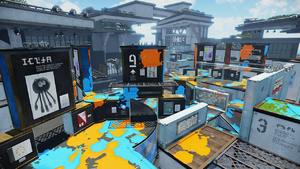
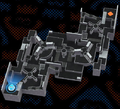
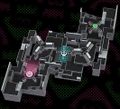
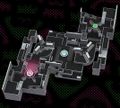
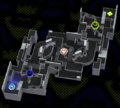














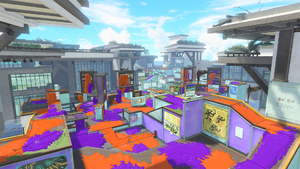






















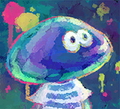




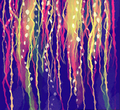


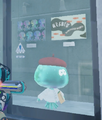



![Campbell's Soup Cans next to a painting of a squid orange[3]](http://cdn.wikimg.net/en/splatoonwiki/images/thumb/3/3e/S_Museum_d%27Alfonsino_Campbell%27s_Soup_Cans.jpg/120px-S_Museum_d%27Alfonsino_Campbell%27s_Soup_Cans.jpg)

